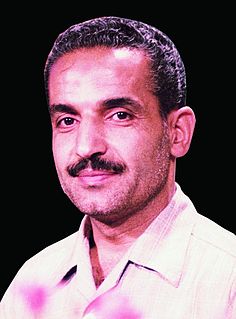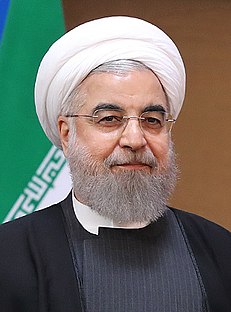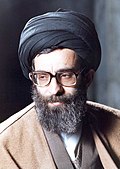
Seyyed Mohammad Hosseini Beheshti was an Iranian jurist, philosopher, cleric and politician who was known as the second person in the political hierarchy of Iran after the revolution. Dr. Beheshti is considered to have been the primary architect of Iran's post-revolution constitution, as well as the administrative structure of the Islamic Republic. Beheshti was assassinated along with more than 70 members of the Islamic Republic Party on 28 June 1981.

Mohammad-Ali Rajai was the second President of Iran from 2 to 30 August 1981 after serving as prime minister under Abolhassan Banisadr. He was also minister of foreign affairs from 11 March 1981 to 15 August 1981, while he was prime minister. He was assassinated in a bombing on 30 August 1981 along with prime minister Mohammad-Javad Bahonar.

Mohammed Sadeq Givi Khalkhali was a Shia cleric of the Islamic Republic of Iran who is said to have "brought to his job as Chief Justice of the revolutionary courts a relish for summary execution" that earned him a reputation as Iran's "hanging judge". A farmer's son from Iranian Azeri origins was born in Givi in appearance Khalkhali was "a small, rotund man with a pointed beard, kindly smile, and a high-pitched giggle."

The Iranian reformists are a political faction in Iran that support former President Mohammad Khatami's plans to change the Iranian political system to include more freedom and democracy. Iran's "reform era" is sometimes said to have lasted from 1997 to 2005—the length of Khatami's two terms in office. The Council for Coordinating the Reforms Front is the main umbrella organization and coalition within the movement; however, there are reformist groups not aligned with the council, such as the Reformists Front.

Ali Larijani is an Iranian conservative politician, philosopher and former military officer who has been Speaker of the Parliament of Iran since 2008. Larijani was the Secretary of the Supreme National Security Council from 15 August 2005 to 20 October 2007, appointed to the position by President Mahmoud Ahmadinejad, replacing Hassan Rouhani. Acceptance of Larijani's resignation from the secretary position was announced on 20 October 2007 by Gholamhossein Elham, the Iranian government's spokesman, mentioning that his previous resignations were turned down by President Ahmadinejad.

Iran's ninth presidential election took place in two rounds, the first on 17 June 2005, the run-off on 24 June. Mohammad Khatami, the previous President of Iran, stepped down on 2 August 2005, after serving his maximum two consecutive four-year terms according to the Islamic Republic's constitution. The election led to the victory of Mahmoud Ahmadinejad, the hardline mayor of Tehran, with 19.48% of the votes in the first round and 61.69% in the second. Factors thought to have contributed to Ahmadinejad's victory include mobilization of mosque networks and conservative/hardline voters, and a protest vote against corrupt elite insiders and for "new political blood". A loyal supporter of conservative Supreme Leader Khamenei, Ahmadinejad kissed the leader's hand during his authorization ceremony. Officials reported a turnout of about 59% of Iran's 47 million eligible voters, a decline from the 63% turnout reported in the first round of balloting a week before.

Mir-Hossein Mousavi Khameneh is an Iranian reformist politician, artist and architect who served as the seventy-ninth and last Prime Minister of Iran from 1981 to 1989. He was a reformist candidate for the 2009 presidential election and eventually the leader of the opposition in the post-election unrest. Mousavi served as the president of the Iranian Academy of Arts until 2009, when Conservative authorities removed him.

Ebrahim Yazdi was an Iranian politician and diplomat who served as deputy prime minister and minister of foreign affairs in the interim government of Mehdi Bazargan, until his resignation in November 1979, in protest at the Iran hostage crisis. From 1995 until 2017, he headed the Freedom Movement of Iran. Yazdi was also a trained cancer researcher.

Liberalism in Iran or Iranian liberalism is a political ideology that traces its beginnings to the 20th century.

The Association of Combatant Clerics is an Iranian reformist clerical political party.

Iranian presidential election of 1997 took place on 23 May 1997, which resulted in an unpredicted win for the reformist candidate Mohammad Khatami. The election was notable not only for the lopsided majority of the winner - 70% - but for the high turnout. 80% of those eligible to vote did so, compared to 50% in the previous presidential election.

The First Iranian presidential election was held on January 25, 1980, one year after the Iranian Revolution when the Council of Islamic Revolution was in power.
The Association of the Women of the Islamic Republic is an Iranian reformist political party. It was the first officially registered party of the Islamic Republic of Iran.

Parliamentary elections were held in Iran on 10 April 1992, with a second round on 8 May. The elections were the first parliamentary elections held in Iran since the death of Ayatollah Khomeini and during Ali Khamenei's leadership.

The Interim Government of Iran, officially the Provisional Revolutionary and Islamic Government of Iran was the first government established in Iran after the Iranian Revolution, and the first nominal republic established in Iran after 2,500 years of Persian monarchy. The regime was headed by Mehdi Bazargan, one of the members of the Freedom Movement of Iran, and formed on the order of Ruhollah Khomeini on 4 February 1979. From 4 February to 11 February, Bazargan and Shapour Bakhtiar, the Shah's last Prime Minister, both claimed to be the legitimate prime minister; Bakhtiar fled on 11 February. Mehdi Bazargan was the prime minister of the interim government and introduced a seven-member cabinet on 14 February 1979. Ebrahim Yazdi was elected as the Foreign Minister.

Hassan Rouhani is an Iranian politician serving as the current and seventh President of Iran since 3 August 2013. He was also a lawyer, academic, former diplomat and Islamic cleric. He has been a member of Iran's Assembly of Experts since 1999, member of the Expediency Council since 1991, and a member of the Supreme National Security Council since 1989. Rouhani was deputy speaker of the fourth and fifth terms of the Parliament of Iran (Majlis) and Secretary of the Supreme National Security Council from 1989 to 2005. In the latter capacity, he was the country's top negotiator with the EU three, UK, France, and Germany, on nuclear technology in Iran, and has also served as a Shi'ite ijtihadi cleric, and economic trade negotiator. He has expressed official support for upholding the rights of ethnic and religious minorities. In 2013, he appointed former industries minister Eshaq Jahangiri as his first vice-president.

Sadeq Tabatabaei was an Iranian writer, journalist, TV host, university professor at the University of Tehran and politician who served as Deputy Prime Minister from 1979 to 1980. He was also Deputy Minister of the Interior and oversaw the referendum on establishing an Islamic Republic in March 1979. He was Iran's Ambassador to West Germany from 1982 until 1986.
The Council for Coordinating the Reforms Front or the Reformist Front Coordination Council is the umbrella organization, coalition and council of main political groups within the Iranian reform movement. Since 2015, it is overseen by the Reformists' Supreme Council for Policymaking.





















